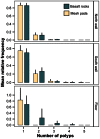Early life history of deep-water gorgonian corals may limit their abundance
- PMID: 23762358
- PMCID: PMC3677872
- DOI: 10.1371/journal.pone.0065394
Early life history of deep-water gorgonian corals may limit their abundance
Abstract
Deep-water gorgonian corals are long-lived organisms found worldwide off continental margins and seamounts, usually occurring at depths of ∼200-1,000 m. Most corals undergo sexual reproduction by releasing a planktonic larval stage that disperses; however, recruitment rates and the environmental and biological factors influencing recruitment in deep-sea species are poorly known. Here, we present results from a 4-year field experiment conducted in the Gulf of Maine (northwest Atlantic) at depths >650 m that document recruitment for 2 species of deep-water gorgonian corals, Primnoa resedaeformis and Paragorgia arborea. The abundance of P. resedaeformis recruits was high, and influenced by the structural complexity of the recipient habitat, but very few recruits of P. arborea were found. We suggest that divergent reproductive modes (P. resedaeformis as a broadcast spawner and P. arborea as a brooder) may explain this pattern. Despite the high recruitment of P. resedaeformis, severe mortality early on in the benthic stage of this species may limit the abundance of adult colonies. Most recruits of this species (∼80%) were at the primary polyp stage, and less than 1% of recruits were at stage of 4 polyps or more. We propose that biological disturbance, possibly by the presence of suspension-feeding brittle stars, and limited food supply in the deep sea may cause this mortality. Our findings reinforce the vulnerability of these corals to anthropogenic disturbances, such as trawling with mobile gear, and the importance of incorporating knowledge on processes during the early life history stages in conservation decisions.
Conflict of interest statement
Figures






References
-
- Roberts JM, Wheeler AJ, Freiwald A (2006) Reefs of the Deep: The Biology and Geology of Cold-Water Coral Ecosystems. Science 312: 543–547 doi:10.1126/science.1119861 - DOI - PubMed
-
- Buhl-Mortensen L, Mortensen PB (2004) Crustaceans associated with the deep-water gorgonian corals Paragorgia arborea (L., 1758) and Primnoa resedaeformis (Gunn., 1763). J of Natural Hist 38: 1233–1247 doi:10.1080/0022293031000155205 - DOI
-
- Buhl-Mortensen L, Mortensen PB (2005) Distribution and diversity of species associated with deep-sea gorgonian corals off Atlantic Canada. In: Freiwald A, Roberts JM, editors. Cold-water Corals and Ecosystems. Berlin Heidelberg: Springer-Verlag. 849–879. doi:10.1007/3-540-27673-4_44.
-
- Etnoyer P, Morgan LE (2005) Habitat-forming deep-sea corals in the Northeast Pacific Ocean. In: Freiwald A, Roberts JM, editors. Cold-water Corals and Ecosystems. Berlin Heidelberg: Springer-Verlag. 331–343.
-
- Auster PJ (2005) Are deep-water corals important habitats for fishes? In: Freiwald A, Roberts JM, editors. Cold-water Corals and Ecosystems. Berlin Heidelberg: Springer-Verlag. 747–760.
Publication types
MeSH terms
LinkOut - more resources
Full Text Sources
Other Literature Sources
Miscellaneous

